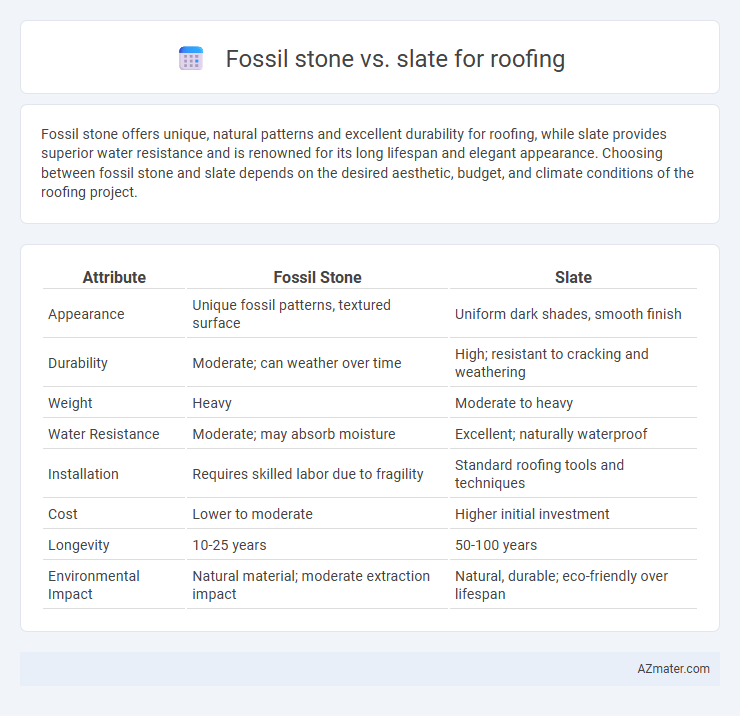Fossil stone offers unique, natural patterns and excellent durability for roofing, while slate provides superior water resistance and is renowned for its long lifespan and elegant appearance. Choosing between fossil stone and slate depends on the desired aesthetic, budget, and climate conditions of the roofing project.
Table of Comparison
| Attribute | Fossil Stone | Slate |
|---|---|---|
| Appearance | Unique fossil patterns, textured surface | Uniform dark shades, smooth finish |
| Durability | Moderate; can weather over time | High; resistant to cracking and weathering |
| Weight | Heavy | Moderate to heavy |
| Water Resistance | Moderate; may absorb moisture | Excellent; naturally waterproof |
| Installation | Requires skilled labor due to fragility | Standard roofing tools and techniques |
| Cost | Lower to moderate | Higher initial investment |
| Longevity | 10-25 years | 50-100 years |
| Environmental Impact | Natural material; moderate extraction impact | Natural, durable; eco-friendly over lifespan |
Introduction to Roofing Materials: Fossil Stone and Slate
Fossil stone roofing offers unique, natural patterns formed from ancient marine deposits, providing both durability and distinctive aesthetic appeal. Slate roofing is renowned for its exceptional longevity, water resistance, and classic, elegant appearance derived from fine-grained metamorphic rock. Both materials resist weathering effectively, making them premium choices for long-lasting, visually striking roofs in residential and historical buildings.
What is Fossil Stone? Key Characteristics
Fossil stone is a sedimentary rock embedded with preserved remains of ancient marine organisms, primarily composed of compacted shells and skeletons. Its key characteristics include a unique textured appearance due to visible fossils, natural durability, and resistance to weathering, making it a decorative yet functional roofing material. Compared to slate, fossil stone offers distinct aesthetic appeal with its organic patterns but may require more maintenance to preserve its distinctive surface.
What is Slate? Key Characteristics
Slate is a fine-grained, metamorphic rock renowned for its durability and natural cleavage, allowing it to be split into thin, uniform sheets ideal for roofing. Its key characteristics include high water resistance, weather durability, fire resistance, and minimal maintenance requirements. These properties make slate a premium roofing material compared to fossil stone, which is generally less dense and more porous.
Aesthetic Differences: Fossil Stone vs Slate
Fossil stone roofing showcases unique, intricate patterns created by embedded ancient fossils, offering a natural, textured look with earthy tones that create a distinct historical charm. Slate roofing features a smooth, uniform surface with subtle color variations ranging from gray to green, blue, or purple, lending a sleek and elegant aesthetic to roofs. The visual contrast lies in fossil stone's organic, rugged character versus slate's refined, consistent appearance, catering to different architectural styles and design preferences.
Durability and Longevity Comparison
Fossil stone roofing offers high durability due to its dense, compact structure resistant to weathering and erosion, often lasting over 50 years with minimal maintenance. Slate roofs excel in longevity, frequently exceeding 75 to 100 years because of their natural cleavage and low water absorption, making them highly resistant to cracking and frost damage. Both materials provide superior lifespan compared to traditional roofing options, but slate's proven endurance and resilience often make it the preferred choice for long-term roof installations.
Installation Process: Fossil Stone vs Slate
Fossil stone roofing typically involves simpler installation due to its uniform thickness and lighter weight, allowing for faster placement and reduced labor costs. Slate requires skilled craftsmanship to handle its brittle texture and variable thickness, demanding precise cutting and secure fastening to ensure durability and weather resistance. Proper installation of both materials is crucial, but slate's complexity often leads to longer project timelines and higher overall expenses.
Maintenance Requirements for Each Roof Type
Fossil stone roofs demand minimal maintenance due to their dense composition, which resists water absorption and weathering, reducing the risk of moss and algae growth. Slate roofs require periodic inspections to replace broken or slipped tiles and preventive treatments to manage moss accumulation, ensuring longevity and structural integrity. Both materials benefit from professional cleaning and sealing, but fossil stone generally offers a more durable, low-maintenance option over time.
Cost Analysis: Fossil Stone vs Slate Roofing
Fossil stone roofing typically offers a more budget-friendly option compared to slate, with installation costs averaging 30-50% lower due to lighter weight and easier handling. Slate roofing, while more expensive upfront, boasts superior longevity of 75-100 years and minimal maintenance, potentially reducing long-term expenses despite higher initial investment. Cost analysis should factor in fossil stone's moderate durability balanced against slate's premium lifespan and aesthetic value in roofing projects.
Environmental Impact and Sustainability
Fossil stone roofing often involves quarrying processes that can disrupt fossil beds and consume significant energy, raising concerns about its environmental footprint. Slate roofing is highly sustainable, offering durability with minimal maintenance and the ability to be recycled or repurposed at the end of its lifespan, reducing landfill waste. Both materials have distinct environmental impacts, but slate's longevity and recyclability make it a more sustainable choice for eco-conscious building projects.
Choosing the Right Material: Factors to Consider
Fossil stone offers natural durability and unique texture, making it ideal for historic or rustic roof designs, while slate provides exceptional longevity and resistance to weather elements, often preferred for high-end roofing projects. Factors to consider include climate resistance, weight, maintenance requirements, cost, and aesthetic compatibility with the building architecture. Evaluating these variables ensures the selected roofing material meets both functional demands and design preferences.

Infographic: Fossil stone vs Slate for Roof
 azmater.com
azmater.com